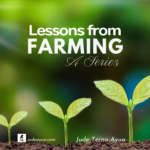By Jude Ayua
Lessons from the Lord’s Vineyard: 1
In Isaiah 5:1-2, God sings a song about a “beloved and his vineyard.” The song highlights significant principles the planter applied with respect to his vineyard.
First, God describes the planter of the vineyard as “the one I love,” which is a symbolism for God’s love for the house of Israel. This description is not only an expression of love for this planter, but also translates to the planter’s care for his vineyard. It is because of this care that he did everything he did for it.
Second, the vineyard is on a “on a fertile hillside.” The first emphasis here is on fertility. The second emphasis is on “hillside,” which suggests the environment. A plant can only grow well on the appropriate soil-type and in favorable conditions. In addition to the right environment, the hillside also symbolizes protection from possible theft, destruction, or intrusion of the vineyard.
Third, “He [the beloved planter] dug it up and cleared it of stones.” This speaks to effort and intentionality. He was purposeful about his vineyard and invested his resources in it. He also followed a step-by-step procedure, beginning with the basics: digging and clearing. The digging was to make room for what he would sow to take root, and the clearing was to give it sufficient space to grow and spread.
Fourth, he “planted it with the choicest vines.” The planter was also intentional about the choice of vines (plants) he sowed in his vineyard. It was the best and not random.
Fifth, “He built a watchtower in it and cut out a winepress as well.” The planter had the intention to watch over his vineyard, to protect it, and to eventually reap from it. The watchtower is a security infrastructure, and the winepress is for processing the vine.
In the next part of the series, we will learn more about how these principles apply to our lives and purpose.
Did you miss the introduction? Read here.







